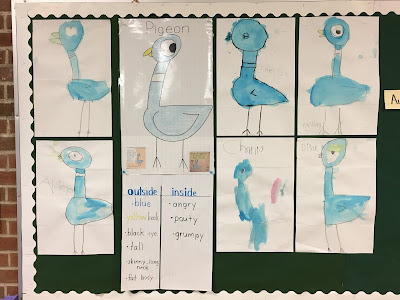Of course, I love Mo Willems! Let me count the reasons why:
#1: Kids love Mo's books and I love whatever kids love ( well, maybe not the cardboard pizza served in the cafeteria.)
#2: Mo's books make everyone laugh. Laughter is good for the heart and the brain, right?
#3: Mo's books help us all think about friendship, patience, conflict resolution, growing up--the stuff of life, really.
#4: These books are outstanding for teaching reading and writing!
So, how do I use Mo Willem's books in my classroom? You are cordially invited to read on !
I like to devote 3/5 of the time to reading and writing fiction, and 2/5 to informational text/writing. We just got a science curriculum, STEMscopes, this year so some of my informational reading/writing is related to science topics. This middle trimester also includes Thanksgiving, Martin Luther King Day, and Presidents' Day, so these are wonderful social studies topics. But informational text/writing is the subject of other posts.... back to Mo!
I have found author studies to be a great way to teach about fiction. By studying the work of one author over the course of a few weeks, certain features and concepts become clear to students. Mo's books are great for teaching many concepts of print, character, and setting:
Parts of a Book
A number of years ago, I found a version of this song in a copy of The Mailbox magazine.
For a week or so, we all sing the song while holding a Mo Willem's book and pointing to the parts as we sing about them.
Describing a Character
Have you ever noticed how the illustrations in the Pigeon series as well as the Elephant and Piggie series are purely of characters? There are NO indications of the settings! So, these two series are perfect for focusing students' attention on characters. After reading several of the Pigeon books, my kindergarteners are ready to begin describing the outside and inside of Pigeon.
The outside/ inside construct makes sense to 5 and 6 year olds. With just a little guidance, they can use color and size words to describe the outside of Pigeon. Describing what a character is like on the inside is more challenging. As teachers, we have to expand our students' vocabulary. I find that using emoticons is very helpful and fun! I also use this as an opportunity to teach opposites which effectively doubles their vocabulary.
| I have made several dozen emoticon cards which can be used to describe characters in many books. Someday I may offer them on TpT! |
"Pigeon is not sweet."
or
or
"Pigeon is grumpy."
I write a few of their sentences in predictable chart form, as well.
Comparing Characters
After reading a few Elephant and Piggie books and describing both characters, we set out hula hoops as Venn Diagrams. One by one, students place the emoticons in the Venn Diagram according to their opinions. We don't always agree on the traits of a character but I think the debate is worthwhile, too! Once again, I write some of their statements in predictable chart form.
"Gerald is grumpy but Piggie is sweet."
"Both of them are funny."
Settings
In the Knuffle Bunny series, we first encounter settings. Some kindergarteners notice the difference right away! They are intrigued by the black and white photo illustrations and the pops of color that are the characters.
As we read, we practice labeling the settings. I emphasize the use of position words when identifying a setting:
"The setting is in a classroom."
"The setting is on a plane."
Thanks to Robin for sharing!
I have also made quick sketches of the settings and written phrases on index cards. I pass these out and each student has a chance to correctly identify a setting from the book.
"Knuffle Bunny is in the laundromat."
"Knuffle Bunny is not in outer space."
And, once again, I write a few of their statements in predictable chart form.
Mentor Texts
As mentor texts, Mo's books are wonderful, too. In Writer's Workshop, we practice writing speech bubbles, writing words really BIG, and making directional lines to show movement.
I love this anchor chart!
I love this anchor chart!
We also watch videos on YouTube of Mo teaching us how to draw Pigeon and Piggie. We practice on our whiteboards then draw and paint them on construction paper. Directed drawing is really great-- it works!
As a follow-up project to Knuffle Bunny, I print backgrounds in black and white using KidPix software on my Mac. I found a drawing of Knuffle Bunny on Pinterest, copy it, and glue it to each background. The kids use Crayola's Sea Green crayon to color in their Knuffle Bunny and then write "My Knuffle Bunny is _______________," finishing their sentences using developmental spelling to indicate their particular setting.
We are now moving on to our next author study, Laura Numeroff's books in the If You Give A .....series. Stay tuned!
















I love Mo! We created some Mo Willems Knufflebunny artwork in our house. It's so fun! And I love Elephant and Piggie for talking about dialogue with older students but I love how you pay attention to what the illustrations are showing us as readers. Great idea!
ReplyDeleteMo Willems to this day is one of my favorite authors, and if you haven't ordered it yet, you must get a copy of Don't Pigeonhole Me, his sketchbook. Definitely for adults, not kids... He is one of the authors students really love to emulate and I love that you chose him for your first author study!!
ReplyDeleteThanks, Alex, for commenting! I’m ordering that book, for sure!! I’m thinking of starting an adult book club where we read young adult and maybe even kids’ books. That could be fun.
Delete